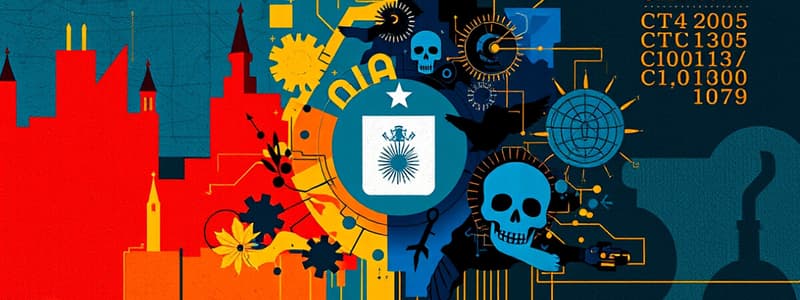Podcast
Questions and Answers
What does confidentiality ensure within the CIA triad?
What does confidentiality ensure within the CIA triad?
- Assets are modified only by authorized parties.
- Assets can be accessed at any time by anyone.
- Assets are viewed only by authorized parties. (correct)
- Assets are available to unauthorized users.
Which of the following best defines integrity in the context of security?
Which of the following best defines integrity in the context of security?
- The ability to ensure that an asset is modified only by authorized parties. (correct)
- The ability to confirm the identity of a user.
- The ability to ensure that assets can be accessed by anyone.
- The ability to read assets at any time.
What does availability refer to in security systems?
What does availability refer to in security systems?
- The confirmation of a sender's identity.
- The ability to deny access to unauthorized parties.
- The ability to modify assets as needed.
- The ability to ensure that assets can be accessed at appropriate times. (correct)
Which property does authentication refer to in communication networks?
Which property does authentication refer to in communication networks?
What is the purpose of auditability in security systems?
What is the purpose of auditability in security systems?
Which of the following is not a part of the CIA triad but is often considered a critical aspect of security?
Which of the following is not a part of the CIA triad but is often considered a critical aspect of security?
Which statement correctly describes nonrepudiation in security systems?
Which statement correctly describes nonrepudiation in security systems?
What is the relationship between authorization and authentication?
What is the relationship between authorization and authentication?
What best defines confidentiality in the context of the C-I-A triad?
What best defines confidentiality in the context of the C-I-A triad?
Which method is commonly used for ensuring the confidentiality of data?
Which method is commonly used for ensuring the confidentiality of data?
What is the definition of integrity within the C-I-A triad?
What is the definition of integrity within the C-I-A triad?
What impact does modification of data have on integrity?
What impact does modification of data have on integrity?
How is availability defined in the context of the C-I-A triad?
How is availability defined in the context of the C-I-A triad?
What is an example of a threat that impacts availability?
What is an example of a threat that impacts availability?
Which type of attack primarily affects confidentiality?
Which type of attack primarily affects confidentiality?
What is the effect of unauthorized interception on the CIA triad?
What is the effect of unauthorized interception on the CIA triad?
What is the primary goal of computer security?
What is the primary goal of computer security?
Which of the following best defines a vulnerability in a system?
Which of the following best defines a vulnerability in a system?
What can be considered a threat to computing systems?
What can be considered a threat to computing systems?
How is the value of an asset determined?
How is the value of an asset determined?
Which of the following factors does NOT typically affect asset value?
Which of the following factors does NOT typically affect asset value?
What is meant by 'auditability' in security systems?
What is meant by 'auditability' in security systems?
What is the definition of integrity in the context of computer security?
What is the definition of integrity in the context of computer security?
Which of the following best describes availability in a security context?
Which of the following best describes availability in a security context?
Flashcards are hidden until you start studying
Study Notes
CIA Triad
- Confidentiality: Restricts asset access to authorized parties only; includes "read"-type actions such as viewing, printing, and reading documents.
- Integrity: Ensures that only authorized parties can modify assets; involves writing, changing statuses, deleting, or creating information.
- Availability: Guarantees authorized parties can access assets when needed; a key concern is preventing denial of service.
Extended Security Properties
- Authentication: Confirms the identity of the sender in communication systems.
- Non-repudiation (Accountability): Ensures a sender cannot deny having sent something, providing accountability.
- Auditability: Allows tracing of all actions related to an asset to maintain oversight of data handling.
- Authorization: Determines if a user has the rights to access certain services; requires prior user authentication.
Perspectives on the CIA Triad
- Harm to assets can be analyzed through four actions: interception, interruption, modification, and fabrication.
- Interception implies unauthorized access to data, impacting confidentiality.
- Interruption results in assets becoming unavailable, affecting availability.
- Modification occurs when unauthorized parties alter data, compromising integrity.
Types of Harm Acts
- Interception: Unauthorized parties gain access, with possible examples including illicit data copying or wiretapping. Silent interception methods may leave no detectable traces.
- Interruption: Can manifest as loss or unavailability, such as destruction of devices or data files and OS failures, severely impacting availability.
- Modification: Involves tampering with assets, such as altering database values or tampering with transmitted data. Detection of such changes can vary in complexity, often eluding simple measures.
Asset Value Determination
- Asset value is subjective and influenced by the owner’s perspective rather than just monetary worth; may vary over time and can be imprecise.
Vulnerability-Threat-Control Paradigm
- The primary goal of computer security is to protect valuable assets by identifying how they may be harmed and establishing mitigation strategies.
- Vulnerability: Represents weaknesses in systems—procedures, designs, or implementations—that can be exploited to cause harm. Examples include failure to verify user identity before data access.
- Threats: Circumstances capable of causing loss or harm, such as human attacks, natural disasters, inadvertent human actions, or internal flaws in hardware or software.
Visual Illustrations
- Figures illustrate distinctions and relationships between threats, vulnerabilities, and security concepts, aiding in understanding computer security's framework.
Studying That Suits You
Use AI to generate personalized quizzes and flashcards to suit your learning preferences.




